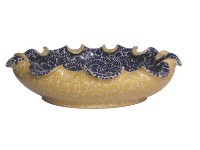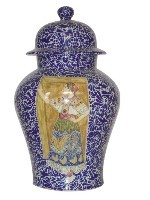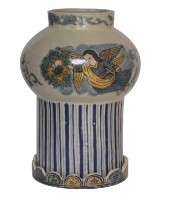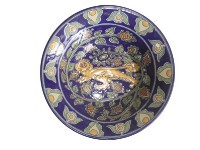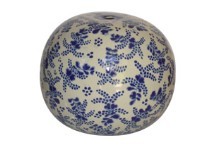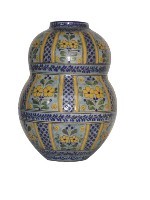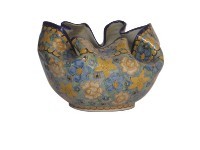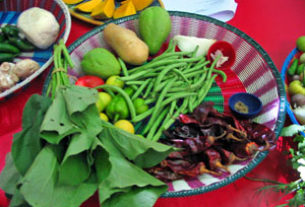Arts of Mexico
There is no more glorious an experience or heightening of the senses than to walk through Puebla’s exquisitely beautiful downtown on a sun drenched afternoon. Every building is a work of art. And everywhere, there are gorgeous tiles, dating back hundreds of years and looking as though they were made yesterday. They adorn the facades of Puebla’s buildings and give elegance to its patios and plazas. They turn the kitchens into visual feasts. They make your head swim from the sheer beauty of it all.
Right from its inception in 1531, Puebla was known for its fine artwork, skilled artisans, and beauty, and Talavera played a central role in making the city the elegant beauty that it was. It started almost immediately thanks to the abundance of quality clay in the region and the number of artists living in the community.
After the Spaniards decimated the pre-Hispanic places of worship, they wanted ceramics to adorn the facades of the numerous churches they were building. Between 1550 and 1570, they brought Spanish potters from Reina de la Talavera in Spain to Puebla to teach the local craftsmen their skills. The Spaniards used a potter’s wheel and were knowledgeable in the production of tin-glazed earthenware. It was a method of working with clay that was unknown to the local artisans. The new method of working and the fusion of styles gave new life to the Mexican earthenware. It came to be known as Poblano Talavera to distinguish it from the Spanish work that originated in Reina de la Talavera.
The new technique in glazing soon spread beyond the azulejos used for the churches and monasteries. It found its way onto pots, plates, jars, religious figures, and the facades of private homes. The tiles were expensive to produce, and it became a sign of wealth to decorate your home with Talavera tiles.
By the mid 1600s, Talavera was in full swing. Guilds were formed and ordinances laid down to ensure that the tiles kept their distinctive style and excellence in craftsmanship. The color blue was to be used only on the finest pieces as the mineral to produce the pigment was very expensive. The master potter had to sign or mark his work. And a yearly examination had to be taken in order for a potter to maintain his position as a master potter. The period between 1650 and 1750 was known as the Golden Age.
In 1813, the constitution eradicated the potter’s guild and revoked the ordinances established in 1653 to standardize production. Now anybody could use this ceramic method in any style they wanted, and the lack of regulations led to a decline in technique and artistic quality. The Talavera market crashed. Out of the 46 workshops in production since the 1700s, only seven remained.
When Enrique Luis Ventosa, a 29-year old Catalan, arrived in Puebla in 1897, there were just six workshops left. Ventosa, a poet and artist, was fascinated by the history and fine craft work that had distinguished Puebla from the rest of Mexico. He became the leading force behind a renaissance in Talavera ware.
He made a thorough study of the original majolica of Mexico and combined it with his knowledge of the old Spanish wares. He interviewed older artisans and published articles on its history and wrote poems based on its traditions. Between 1900 and 1905 he decorated ceramics in the workshop of Antonio Espinoza. In time, he became known as a leading artist in the historic Puebla tradition.
In 1922 Ventosa befriended Ysauro Uriarte Martinez, a young potter who had just inherited his grandfather’s workshop. The two men collaborated to create unique works of ceramic art introducing pre-Columbian art into the motifs along with the Islamic, Chinese, and Italian influences already present. There was even a touch of Art Nouveaux. Between them, the quality of Talavera was restored.
The times couldn’t have been more fortuitous for re-vitalizing this beautiful craft. The revolution had just ended and Mexico was in a period of reconstruction. Tiles were in demand.
An irony in the history of Talavera is that when the craft was at its nadir, an interest developed in collecting the work. In 1904 an American named Emily Johnston de Forrest traveled to Mexico with her husband and discovered Talavera. She established contact with scholars, collectors, and dealers who assisted her in building her collection. Eventually her collection was given to the Metropolitan Museum of Art in New York City.
While in the throes of her love affair with Talavera ware, she passed on her enthusiasm to Edwin Atlee Barber, curator of the Pennsylvania Museum of Art. In 1907, he came to Mexico to study the history of Puebla pottery and acquired an example for the museum. He had a discerning eye and, by the following year, he had a substantial collection. He learned enough in a short time to define the major stylistic periods and distinguish the finest examples. He published his finding in 1908, and it’s still the bible on the study of Talavera.
Americans weren’t the only ones to recognize the unique quality of Talavera ware. In the late nineteenth century important museum collections were assembled in Mexico. One of the earliest and most important was the collection of Francisco Perez Salazer in Mexico City. A bit later, in the twenties, Franz Mayer, a German born stockbroker started collecting. He was known in Puebla as the “crazy man” because he’d buy all the “old stuff” from the locals. In 1986 the Museo Franz Mayer opened in Mexico City with the largest collection of Talavera Poblano in the world — 726 pieces from the seventeenth to the nineteenth century and some twentieth century pieces by Ventosa.
In Puebla, Jose Bello y Gonzalez and his son Jose Mariano Bello y Acedo sought the advice of Ventosa to start their collection. They amassed the largest and most important collection in the city. Today it is housed in the Museo Jose Bello y Gonzalez and is worth a visit. The scope of the collection is extraordinary.
While I was in Puebla I visited the Uriarte showroom, the workshop now run by a group of businessmen with the same high standards as the original owners, and the Santa Catarina workshop run by Lic. Fernanda Gamboa, both owner and ceramicist in her own right. Ms. Gamboa is an interesting potter because she does traditional work and also designs modern pieces, keeping both to the high standards that Talavera has come to be identified with.
She is a member of the Consejo Regulador de la Talavera, a body which monitors the authenticity and assures the high standards of the craft. If a workshop passes their criteria, it gets a certification. So far, only nine workshops have been given certification. They are Uriarte Talavera, Talavera La Reyna, Talavera Cesar Torres, Talavera Casa Celia, Talavera Santa Catarina, La Nueva Espana, Talavera de la Luz, Talavera de las Americas, and Talavera Virglio Perez.
Ms. Gamboa told me that every workshop that wants to be certified has to pass 16 laboratory tests with internationally certified labs in order to get permission. The workshops are inspected every six months to be sure the craftsmen are using the correct materials.
I asked Ms. Gamboa what the buyer should look for in purchasing Talavera. She told me that you should make sure the hologram and certification of the workshop is on the piece. And to make sure that only the six original colors are used — cobalt blue, light blue, black, orange or terracotta, yellow, and two green tones. Some workshops use an extra color called rich rose. You also have to look for the right glaze color which is never white.
Should you be interested in seeing her work or buying a piece of her certified pottery, her web address is talaverastacatarina.com and her phone number in Mexico is 222-247-6614.
I looked at the guidelines and saw they leave little leeway for carelessness in the process. All work must originate in Atlixco, Cholula, Puebla, or Tecali — all in the state of Puebla — and the clays must be obtained from natural deposits in the Talavera zone. The pieces must be hand formed or thrown, never poured into molds. And the glazes must contain a tin and lead base and follow the formula of colonial times. (The blue and/or yellow can have a bas-relief look.) The glaze must craze and be slightly porous, and the designs have to be hand painted with the six original colors formulated from pigments made at the workshop, following long-established formulas. On an authentic piece of Talavera, the paintings should fuse into the glazing giving a sort of blurred appearance, and the work should have the irregularities found in all handmade pieces.
Talavera is expensive for a Mexican craft, but each piece is unique and of extraordinary quality. There are many imitations on the market, but an original piece is worth the price. Its beauty is timeless and the pleasure it gives is priceless.
Images provided by: Santa Catarina Workshop, Cholula, Puebla. 222-247-6614

